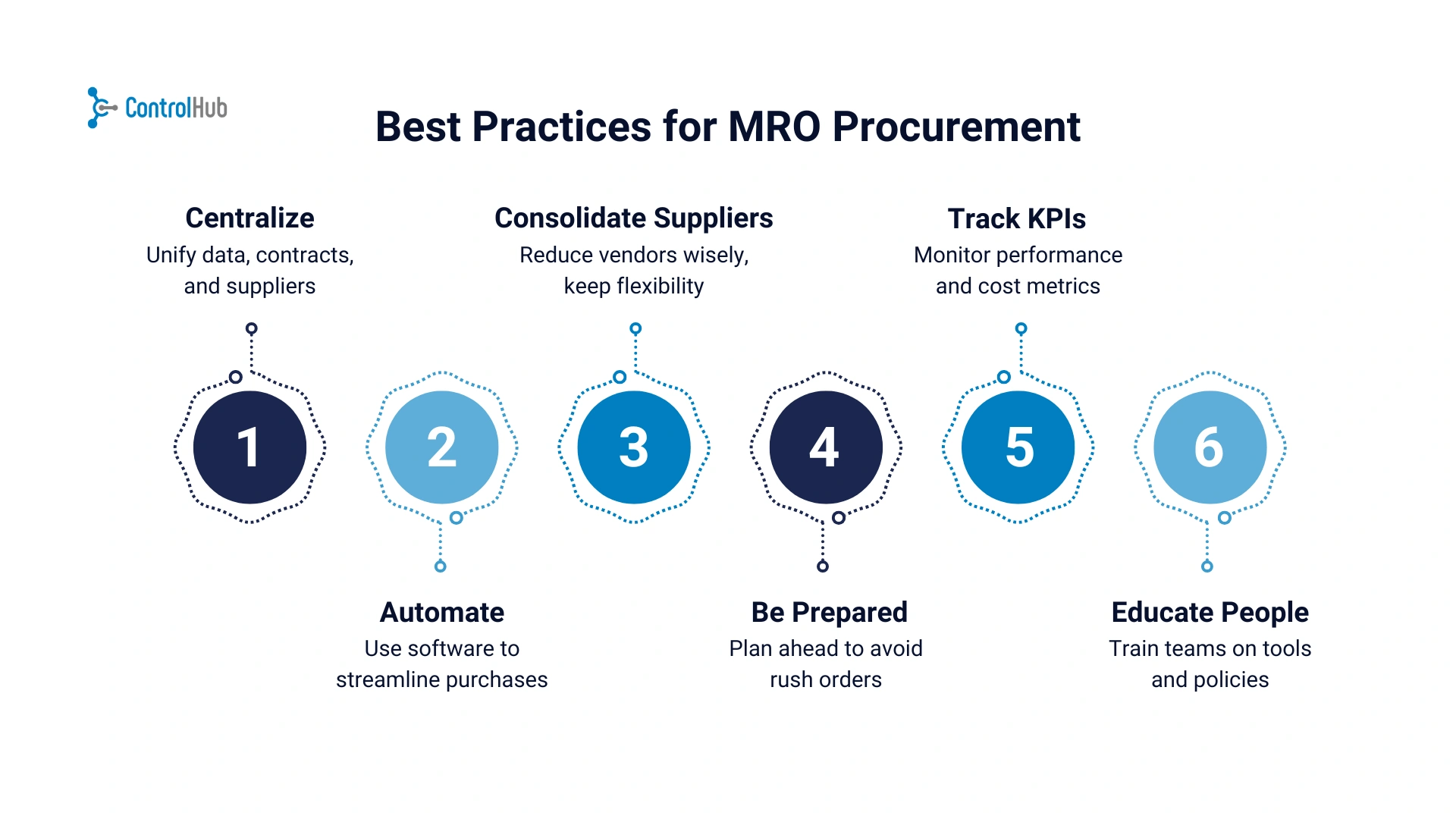Free Supplier Risk Scorecard Download
Download our free supplier risk scorecard here!
Download the free tool!AI Summarize:
So procurement…
It's so common to discuss it that you'll believe there's nothing new to learn.
We know, after all that, without procurement, businesses can't run. You need supplies to keep your operations working.
But have you ever stopped to think about those minor, almost non-relevant purchases you make to maintain or repair something?
That's MRO procurement for
you, and yes, it's definitely more important than you could think.
What's MRO?
Let's remove those letters out of the way. MRO stands for: Maintenance, Repair, and Operations. For procurement, it means sourcing all the minor items your business requires to support the upkeep of equipment, facilities, and infrastructure.
MRO procurement is considered indirect spend; it doesn't have a big role in your final products, but rather operates behind the scenes to make sure daily activities keep moving forward.
One of the things that makes MRI procurement a bit difficult to handle is that, given its overlooked nature, it's not always seen as a centralized purchase process, meaning anyone can buy whatever they need, the moment they need it, without too much control.
Challenges of MRO Procurement
Not to make a big drama out of nowhere, but MRO procurement can rank without problems for a top place in the list of procurement challenges.
The reason?
It can be as messy as it gets
Expensive and with zero standardized processes to rely on, MRO procurement can quickly give you serious headaches.
It's scattered
And this is, without question, the biggest reason why MRO procurement has a reputation for being difficult.
Do you have a large company with many departments?
Good luck trying to figure out who purchased what and why.
To make things worse, each department might have its own preferred suppliers, a huge obstacle if you are looking to understand the big picture.
Sometimes it's invisible.
In all honesty, most of the problems associated with MRO procurement are a case of “it's not you, it's me.” It's not that MRO is bad; it's that the lack of processes around it makes the situation complicated. Because MRO is indirect, it doesn’t always get tracked closely. It often hides in tail spend or gets lost in miscellaneous categories. And if you want to analyze, optimize, or justify decisions?
That's where the chaos starts.
High costs
If the people of your company make MRO purchases at will, with no afterthought, how can you be sure that what has been purchased fits your budget?
How can you make the best of supplier negotiations?
Yeah… that's a bit tricky
Lack of visibility
This is a common one and not solely restricted to MRO. Many companies still track MRO with spreadsheets or legacy systems that don’t talk to each other. That means zero real-time inventory visibility, inconsistent item naming, and a whole lot of manual work just to figure out what’s where.
Best Practices for MRO Procurement
Okay, so MRO procurement comes with a set of challenges, but that doesn't make it less necessary for any business.
The good part?
If you stick to some strategies, MRO procurement doesn't have to be a pain to manage.
Bring things together
Also known as centralized
To make things work for MRO, the first step to consider is moving away from the mess that scattered processes represent. Maybe you just need to sit down with your team and have a chat about purchasing procedures, maybe it's time to upgrade those messy spreadsheets to a single digital platform.
The goal here is to gain control over contracts, suppliers, and procurement data.
If possible, connect your procurement system with your maintenance software, so everything from planning to purchasing talks to each other.
Automate
Yes, this is a recurring one, but with good reason.
Want to get rid of the procurement chaos fast?
Implement procurement software.
Automation is pretty good at making purchasing more efficient and smarter.
So you can always buy from the right supplier at the right price. Some platforms even flag when you're overordering or paying above budget.
Consolidate suppliers…when it makes sense.
Having too many suppliers available can become a problem under certain circumstances.
By narrowing your supplier base, you can boost volume discounts, simplify reordering, and strengthen relationships. But this doesn’t mean you go with just one vendor for everything. Segment your MRO categories and consolidate where it makes sense. You don't want to risk flexibility over efficiency.
Try to find a balance that works for your business.
Be prepared
Yes, MRO procurement is important, but you can bet you'd make better decisions if you knew what to be prepared for.
Do you have some products or locations that need to be maintained or repaired from time to time?
Great, so you can plan purchases in advance. This might sound obvious, but it's the most straightforward way to avoid last-minute panic-induced purchasing and the consequent higher pricing that comes with that.
Track KPIs
Because how else are you going to measure the success of your strategy?
KPIs exist for a reason: to help businesses like yours understand whether you're going in the right direction.
Useful KPIs include fill rates, emergency vs. planned purchases, vendor performance, inventory turnover, and total cost of ownership.
Educate your people
MRO purchases are mostly made by your employees. So why shouldn't you teach them the best practices to handle MRO with zero risks?
A little training on how to use procurement tools, follow workflows, or stick to preferred suppliers goes a long way.
Free Supplier Risk Scorecard Download
Download our free supplier risk scorecard here!
Download the free tool!Major Categories of MRO Procurement
Maintenance supplies
Tools and parts needed to service and repair equipment. Think gaskets, bearings, fasteners, belts, and machine components. They're pretty essential to preventing breakdowns and keeping production in your company as perfect as possible.
Cool?
Well, unplanned downtime costs can quickly pile up if your stock isn’t properly managed.
Spare parts
Ever had to repair a critical part of your company's tools?
This is the stuff you don’t always need, but when you do, you need it right away.
Managing these parts is tricky because they’re often expensive and have long lead times, but they’re crucial for your business continuity.
Items for daily operations
Nothing too fancy here: light bulbs, gloves, filters, batteries, lubricants, and safety signage. They might seem small, but run out of them and suddenly you'll understand why you've to keep them in your stock.
Safety and PPE
Gloves, helmets, goggles, respirators, these guys are rarely optional.
They’re compliance-critical and usually tied to main regulations, which means procurement needs to work to guarantee consistency, availability, and quality.
Free Supplier Risk Scorecard Download
Download our free supplier risk scorecard here!
Download the free tool!The Lesson
MRO procurement might not dominate the conversation when it comes to procurement, that doesn’t make it less relevant for your cost-saving strategies, however.
We’ve looked at what MRO procurement really involves, the hidden challenges that make it messy, and the practical strategies that can help turn it into a source of savings and efficiency.
By centralizing purchases, leveraging tech, segmenting your inventory, and focusing on the categories that matter most,maintenance parts, spares, consumables, tools, and PPE, you’re setting the stage for more agile operations and better cost control.
Free Supplier Risk Scorecard Download
Download our free supplier risk scorecard here!
Download the free tool!Free Supplier Risk Scorecard Download
Download our free supplier risk scorecard here!
Download the free tool!Key Takeaways
- MRO procurement covers all the supplies and parts needed to keep your operations running—think tools, safety gear, cleaning products, and spare parts.
- It’s part of indirect spend, which makes it easy to overlook—but that invisibility can lead to big costs and headaches.
- Common challenges include decentralized buying, lack of visibility, emergency orders, and messy inventory practices.
- You can get ahead by centralizing procurement, using tech tools to automate and track spend, and working with a tighter, smarter supplier list.
- Break your MRO items into clear categories: maintenance supplies, repair parts, consumables, PPE, and tools—each one needs its own sourcing strategy.
- Don’t treat everything like an emergency. Shift toward preventive planning and stock what matters most.
- Start small: audit your current setup, involve your internal teams, and focus on cleaning up just one area at a time.
%20(1).avif)















.png)


